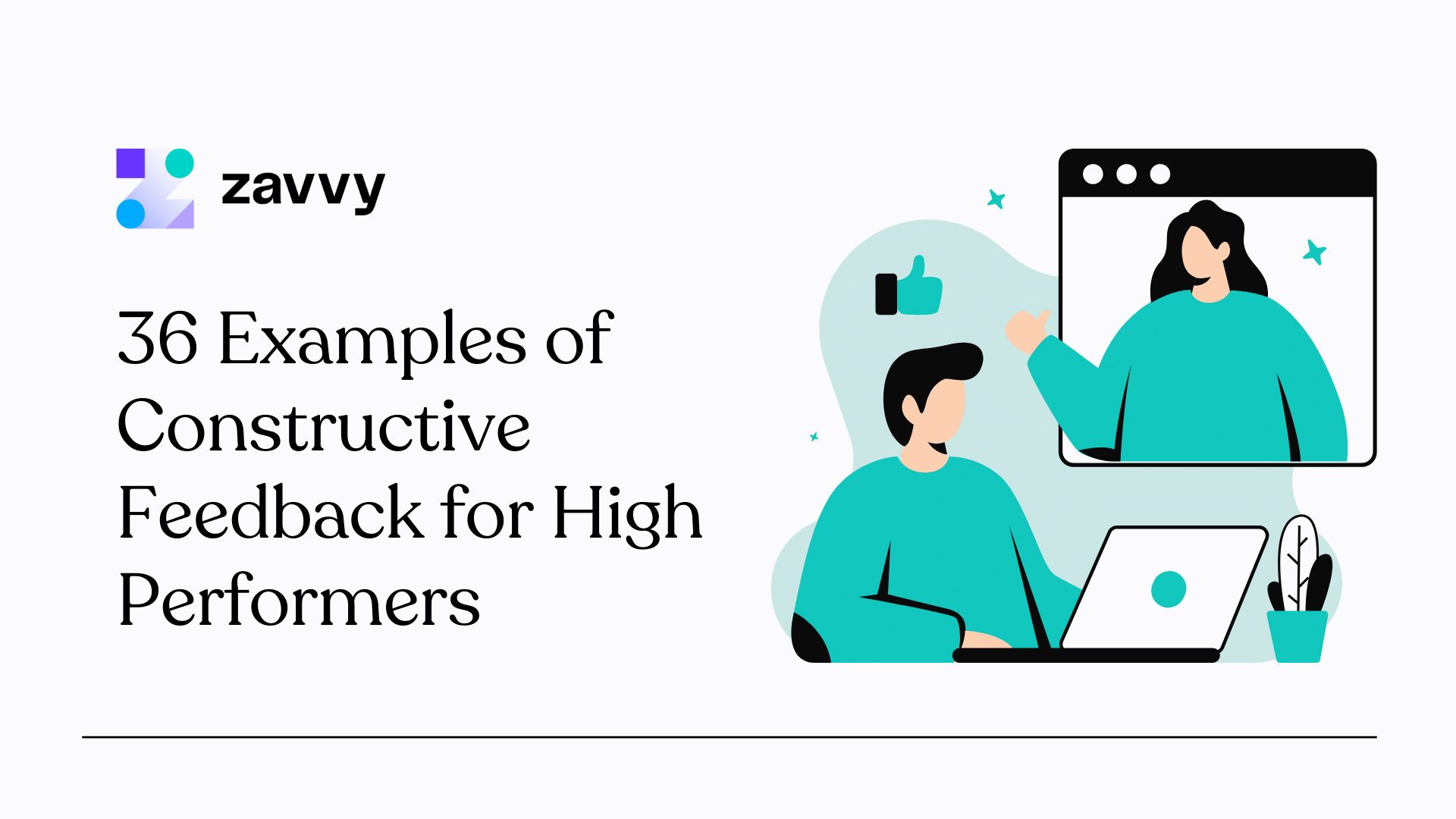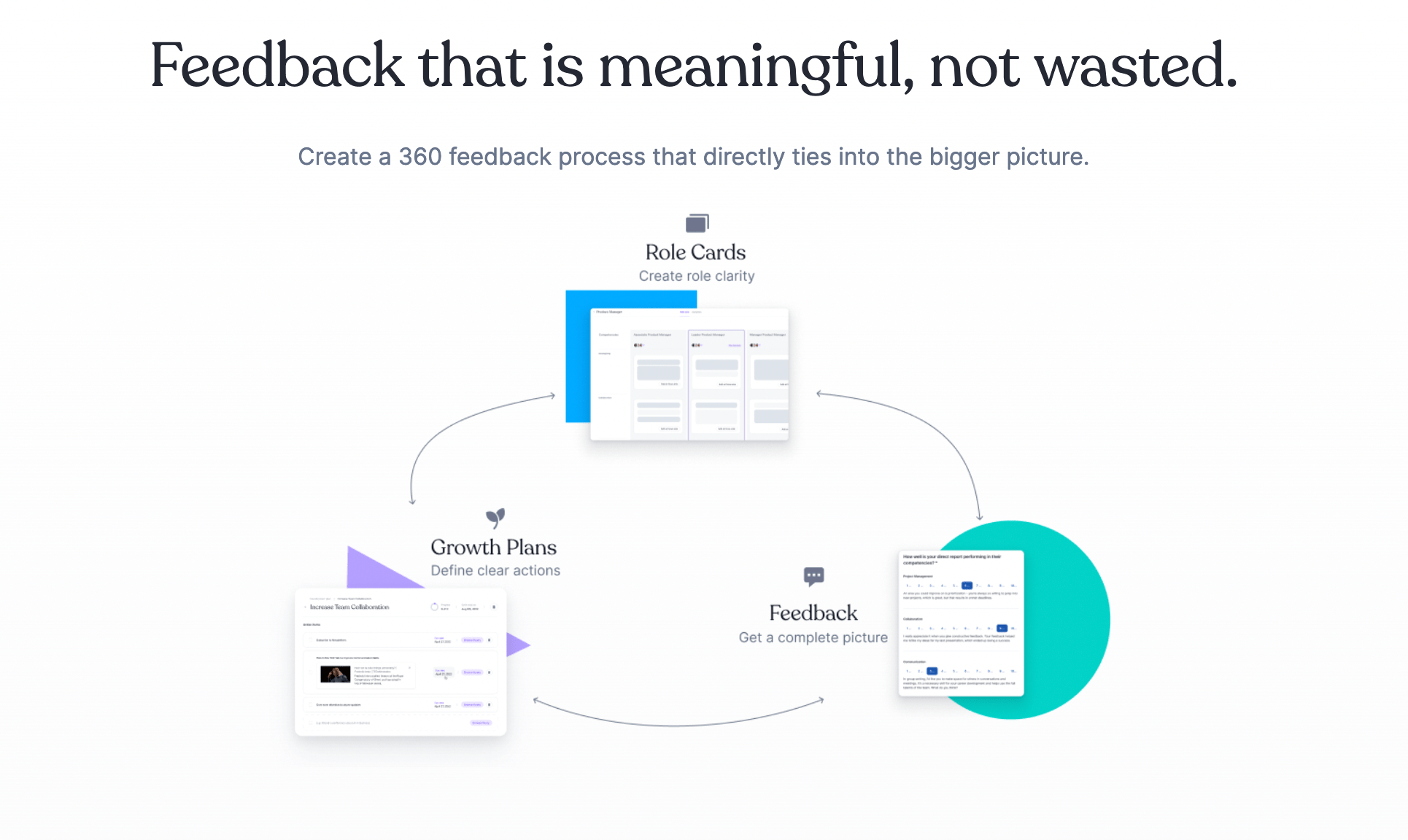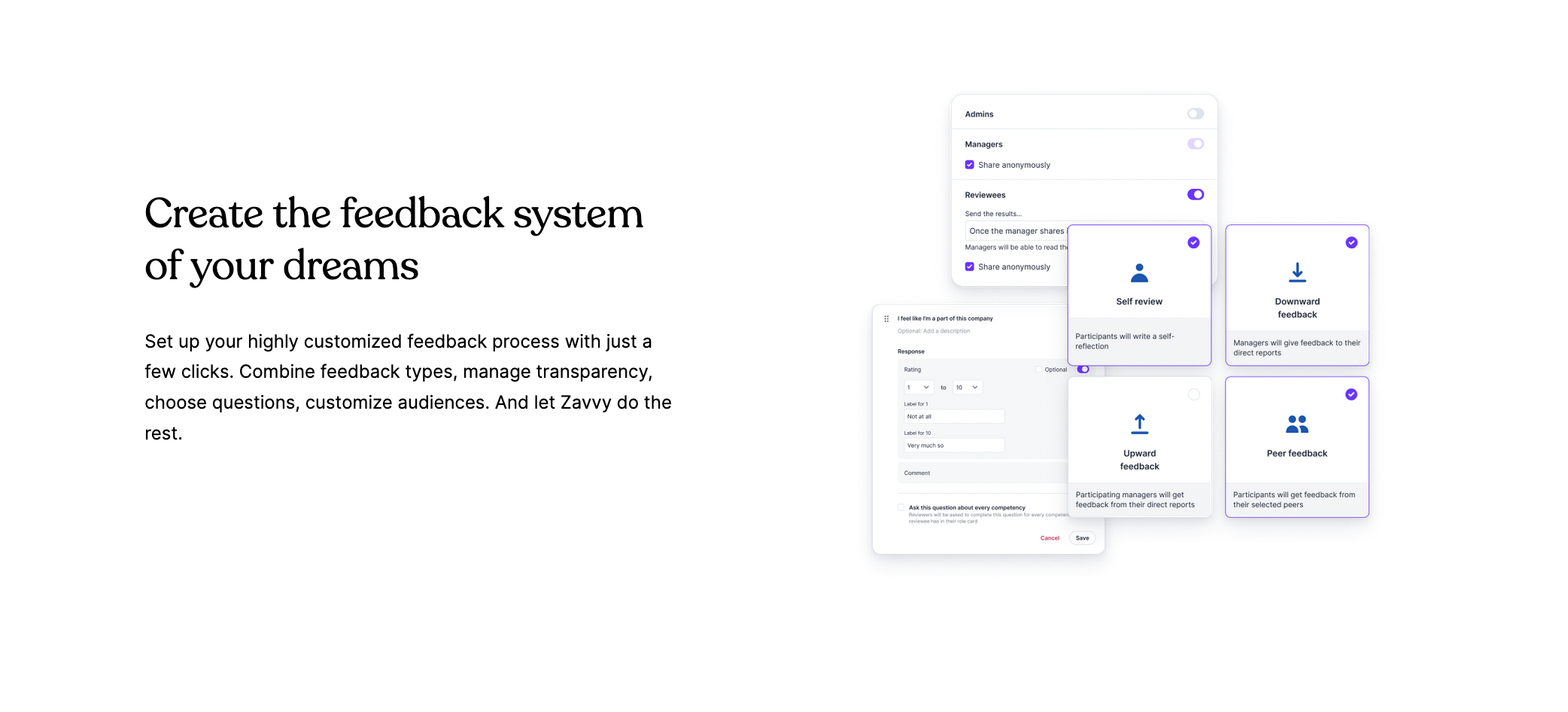
Keke Kaikhosroshvili
Keke is Zavvy's expert in learning experience. On our blog, she shares experience and insights based on her studies in learning design and experiences made with our customers.


Compared to low performers, it's easy giving feedback to high performers. Or is it?
A survey by Leadership IQ revealed high performers to be less engaged at work than low or middle performers. On the other hand, a survey by Jack Zenger and Joseph Folkman shows feedback helped 69% of employees engage and perform better.
When placed side-by-side, these numbers make it obvious that a comprehensive feedback system is what your high performer is looking for.
Still, you might be second-guessing yourself every time you want to review a top performer by asking:
❓How do I deliver critical feedback without making them feel attacked or criticized?
❓Am I being nitpicky and over demanding?
❓Are they even used to criticism, or are they used to effortlessly being the best?
You might have an easier time approaching average or low-performing employees with feedback, as they make easily noticeable mistakes. But, with a top performer, these mistakes may not be as obvious, making you hesitate even to bring it up in the first place.
To help you with this, we've put together a guide that tells you:
Together with our curators, we have created a library of actionable digital marketing resources. Personalized to your team's needs.
Constructive feedback is specific, objective, and actionable input that helps high performers identify what's holding them back.
Your star employees want constructive feedback because it helps them:

Creating a feedback culture in your workplace has immense benefits, from engagement to productivity and talent retention.
➡️ Discover examples of high-performance companies developing a winning feedback culture.
Constructive feedback works both ways. Employees should be able to tell you where to improve too!
Tip: Negative or positive feedback with zero actionable steps will not affect your employees' performance.
➡️ To get constructive feedback right, check out our guide on constructive feedback.
Constructive or not, feedback is often unpleasant, so do employees want it? As far as high performers are concerned, yes, they do because they're built differently. Here's what sets them apart.

High performers have tunnel vision. So they need you to tell them what to apply this tunnel vision focus to and even tell them when they're going overboard.
High performers are purposeful, which motivates them to persist through setbacks.
High performers are passionate about what they do and go the extra mile to get the job done.
While an average employee may be annoyed by extra input as it often means more work, high-performing employees welcome it with a positive attitude.
High performers understand that for a company to succeed, everyone must work together.
As a result, high performers take time to learn about the company as a whole and how their role fits into the bigger picture. They proactively seek both positive and negative feedback to better contribute to the company's success.
High performers have a "try, try, try again" mentality.
When delivered effectively, positive feedback can encourage growth.
On the other hand, rude or insensitive negative feedback can do serious damage to working relationships.
Now that you have a high-performer persona in your mind, here's the right approach to reviewing them.

With every piece of feedback you offer to your high performer, ask yourself– what's in it for them?
Sure, the stars of your company want to see the company succeed, but true motivation would come from seeing how your success helps them succeed too.
Once you know how your feedback can directly benefit them and not just your business, link that benefit to the contribution you want them to make.
Let's take two concrete examples.
You want the employee to include peers in future projects. How do they benefit?
Include Jane and Mark more in your future projects. (Benefit:) Being a team player will make you a better leader and increase your chances of being promoted in the next few years.
You want the employee to attend more morning meetings. How do they benefit?
Attend more morning meetings, even if that means jumping into work 30 minutes later. (Benefit:) This will allow the team to sync with you and give you crucial project updates sooner.
You can do this by:

For example, let your employee take the lead on a new project, and push them to lead presentations if you know they need practice doing that.
You may be constantly looking for results that show your feedback is working its magic. That may not be the best approach.
Instead, look for changes in behavior that show your high performer is working towards that result.
For example, you told your high performer to be more social. The ideal result would be seeing them attend every office event and become very sociable.
However, it's unlikely that this will happen immediately. If you see them making efforts to be a team player, attending more meetings, and trying to talk to more team members, that's reason enough to celebrate.
Your high-performer already works hard and sets difficult goals, so that isn't something you need to tell them to do.
Instead, identify what isn't working and help them fix it.
Tip: Make sure that your high performers always have a higher target by setting up growth plans with specific action items and objectives.
For example: Your sales lead is working long hours and taking on too many projects. You can spot signs of burnout, and it doesn't help that they also miss deadlines. A review at this stage would focus on telling them to slow down and take on less work.
Do not fall in the trap of telling them to work harder or hack their productivity.
A survey by Ranstead USA shows that 60% of employees feel they need to leave their current job to make career advances.
It seems that employees are:
Tip: Create a job leveling matrix to map your high performer's progress and future goals. This way, they will always have a higher targer to work towards, greater than their day-to-day tasks.
Use the job leveling matrix and the employees' own growth plan to understand what to highlight in your feedback process.
Maybe they need training or a chance to show you they're ready for more responsibility. Find out.
Acknowledging your high performers' progress and result will motivates them to stay on the same track. It will also engage them and five a higher sense of purpose.
Acknowledge your high-performer with:

A one-way system for feedback reeks of bias.
Your high performers, and employees in general, should be able to tell you how you're doing when leading and managing the workspace.
Tip: A 360 feedback system makes it easy to collect feedback from:
Opening yourself to upward feedback shows you are eager to learn and adjust to employee needs. It's a great recipe for building trust in the workplace.
When you see an employee going above and beyond, let them know. Explain how their actions are making a positive impact on the company. Don't only initiate a conversation about poor performance.
Communicate this to make employees feel appreciated and give them a clear understanding of what you expect from them in the future.
Usually, employees spend a lot of time thinking about their needs before voicing them– meaning they're working in discomfort for quite some time. So cut to the chase and ask them first.
Some high performers may need to:
Ask, and you will receive answers.
Tip: Use a recurring pulse survey to identify any challenges.
It's difficult to boost employee performance with just one feedback session every year.
When you schedule regular feedback, your employees know they're on your radar, so you're noticing growth and negative behavior.
As a result, they're more likely to be engaged and productive. Regular feedback also prevents problems from festering.
Richard Brandenstein from FBR Law says:
"If a high performer feels like they are performing well but not receiving recognition or reward, they may feel obliged to move elsewhere."
When assessing a high performer, look for specific examples of exceptional work and use language that is positive.
Here are a few handy phrases you can use during review time with your high performer. We grouped them by theme, so you can have an easier time finding the right statements for your employers.

Goal-setting feedback assesses whether high performers are meeting standards and sets the tone for the future.
High-performers are looking for the next milestone to work towards in their career path. Use this section to figure out what that can be.
High-performers don't want to waste time. They need you to identify what they are efficient with and what they still need to perfect.
High performers can be a major source of innovation and creativity.
But, unfortunately, they can become bogged down in the details of their work.
High performers are often not used to working in a team environment. As a result, they may need some guidance on how to work with others.
There is no substitute for clear and effective communication.
High performers can give themselves a real edge by developing this essential skill.
High performers can become complacent or negative. Good feedback conversations help ensure high performers stay on the path to success.
Organizational skills can be essential for maintaining high performance. Targeted, actionable feedback can help develop this.
High-performers would benefit the most from advanced technology. Identifying if they need technical training or resources through the feedback channel may quadruple their productivity.
A future leader may become overbearing if not checked. Identify areas where they can improve and provide corrective action to hone their leadership skills.
Creating a feedback culture at your workplace will allow your employees to discover their strengths and weaknesses without having to wait all year to find out.
Look at it this way, would you want to waste a whole year on a lead generation method that doesn't work? Re-strategizing earlier would save you tons of time and money.
Just like your business, employers want to use their resources best. Feedback is crucial to this.

Zavvy's 360 feedback software makes it effortless to build a solid feedback system, with 3 steps:

If you want a system that does it all, our 360 feedback system helps you organize value-packed 1:1s, monthly reviews, quarterly check-ins, and even self-assessments.
There's no messy endless rescheduling, and it's easier to convince your high-performers to introspect when it's this convenient!
Get in touch and book a free 30 minutes demo right away.
Upskill your team every week with the best contents and personalized recommendations.

Compared to low performers, it's easy giving feedback to high performers. Or is it?
A survey by Leadership IQ revealed high performers to be less engaged at work than low or middle performers. On the other hand, a survey by Jack Zenger and Joseph Folkman shows feedback helped 69% of employees engage and perform better.
When placed side-by-side, these numbers make it obvious that a comprehensive feedback system is what your high performer is looking for.
Still, you might be second-guessing yourself every time you want to review a top performer by asking:
❓How do I deliver critical feedback without making them feel attacked or criticized?
❓Am I being nitpicky and over demanding?
❓Are they even used to criticism, or are they used to effortlessly being the best?
You might have an easier time approaching average or low-performing employees with feedback, as they make easily noticeable mistakes. But, with a top performer, these mistakes may not be as obvious, making you hesitate even to bring it up in the first place.
To help you with this, we've put together a guide that tells you:
Get a demo!
We'll be happy to show you around and answer all your questions.
Trusted by innovative companies



We'll be happy to show you around, answer your questions, or arrange a free trial.
Erhalten Sie eine kostenlose Demo unserer Onboarding-Software.
Vertraut von



Your Training & Development Strategy - Solved in 1 Tool.
Trusted by innovative companies



We'll be happy to show you around, answer your questions, or arrange a free trial.
Learn how Zavvy helps you drive performance, development, and engagement.
Trusted by innovative companies



We'll be happy to show you around, answer your questions, or arrange a free trial.
We'll be happy to show you around and answer all your questions.
Trusted by innovative companies



We'll be happy to show you around, answer your questions, or arrange a free trial.
Gerne zeigen wir Ihnen ganz unverbindlich unsere Plattform im Detail.
Vertraut von modernen Unternehmen



Get a demo!
We'll be happy to show you around and answer all your questions.
Trusted by innovative companies



We'll be happy to show you around, answer your questions, or arrange a free trial.
Erhalten Sie eine kostenlose Demo unserer Software für Mitarbeiterenwicklung und Training.
Moderne Unternehmen
setzen auf Zavvy


